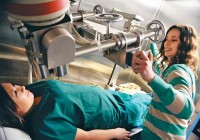
Jennifer Lemons adjusts the detectors in accordance with Lyndi Owens' weight and height before she gets counted. All volunteers are required to change into scrubs before the test because polyester in clothes can cause skewed results.
From the Current-Argus, Carlsbad (2/17/2013) — It may look like a torture chamber at first glance, but a step inside the mysterious cast iron room at the Carlsbad Environmental Monitoring and Research Center tells more of the story.
Adrianne Navarette and Jennifer Lemons are research scientists at CEMRC, where they frequently perform radiation tests, called whole body counts, on workers from nuclear radiation sites like the Waste Isolation Pilot Plant. But the women are in need of more public counts, meaning volunteers from Carlsbad who don’t work in a highly radioactive environment on a daily basis.
Past research studies have been conducted using correlations between radiation in smokers versus nonsmokers and from where people live and what they eat, and according to Navarette, most scientific research depends on volunteers. But now that people in Carlsbad have grown comfortable with the idea of having a nuclear waste plant so close, the data has begun to dwindle. One of the first things that Navarette explains to anyone getting counted is that radiation is not a scary word.
“It’s energy that is naturally occurring,” she said. And according to the 10 minute video that all volunteers must watch before their count, radiation is given off from food, clothing and other everyday things that humans come in contact with on a regular basis.
Most clothing articles contain polyester which attracts radon, and that’s why volunteers are asked to change into special Tyvex garments before the count.
After the quick change and a measurement of height and weight, it’s time to lie on the bed surrounded by 300,000 pounds of cast iron that is free of radiation found in modern steel and other metals.
“While you lay on the bed for 30 minutes you’re emitting radiation,” Navarette said. She or Lemons fit four lung detectors onto the volunteer’s chest which work with the four whole body detectors underneath the bed to send information to the main computer, where Navarette and Lemons view the spectrum – which resembles an electrocardiogram – results of the radiation being emitted.
And the 30 minutes go by quickly, Navarette said. The person getting tested can either catch a cat nap or sing along to the Pandora radio station of his choice.
After the count, Navarette and Lemons go over the person’s results. The women look for peaks in the spectrum results to find out which radioactive isotopes are positive. For WIPP and other nuclear site employees, plutonium is a common – but not dangerous – peak to see, which happens at around 17 kilo electron volts.
Another peak, which Navarette said occurs in 23 percent of Carlsbad residents tested, is cesium-137, one of the most common fission products. According to research, the cesium stems from the nuclear testing conducted in Carlsbad in the 1940s and ’50s, Navarette said, and can be found in people who are born and raised in this area or eat homegrown foods.
“The cesium comes from dirt in the air. If you eat the animals that eat the plants, there is a slight possibility there might be more cesium, but it’s nothing to be worried about,” Navarette said.
In her five years of performing the whole body counts with CEMRC, Navarette said she’s never found a dangerous level of radiation in anyone, including a local who traveled to Japan to help with the tsunami relief work after the nuclear reactor plant crisis. “I can say that from what I’ve seen, everybody in Carlsbad is safe, and that’s the whole point. We’re here to make the public feel better and feel safe,” Navarette said, and to compile data.
Navarette and Lemons perform whole body counts from 9 a.m. to 3 p.m. daily, and all it takes is a quick call to (575) 234-5533 to schedule and less than an hour to donate to science while also securing peace of mind.
By Natalie Gross Current-Argus staff writer


